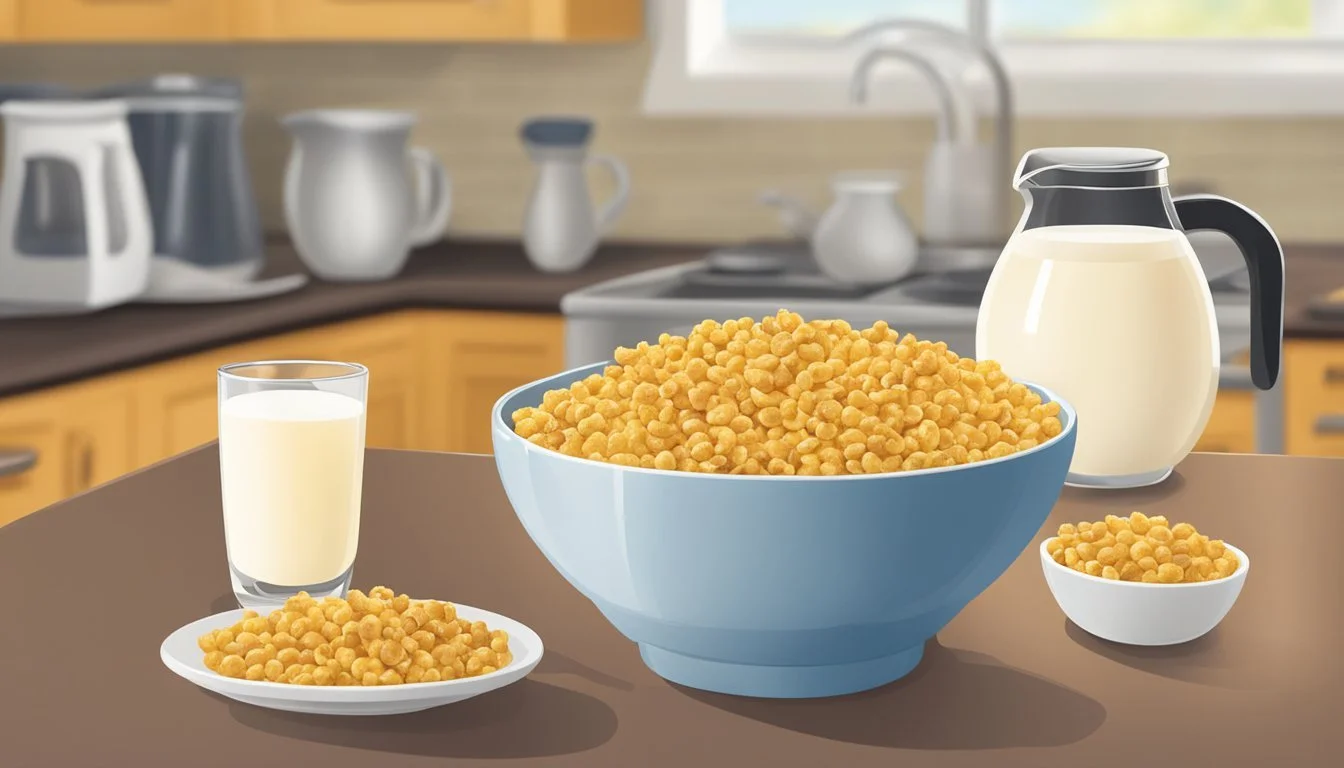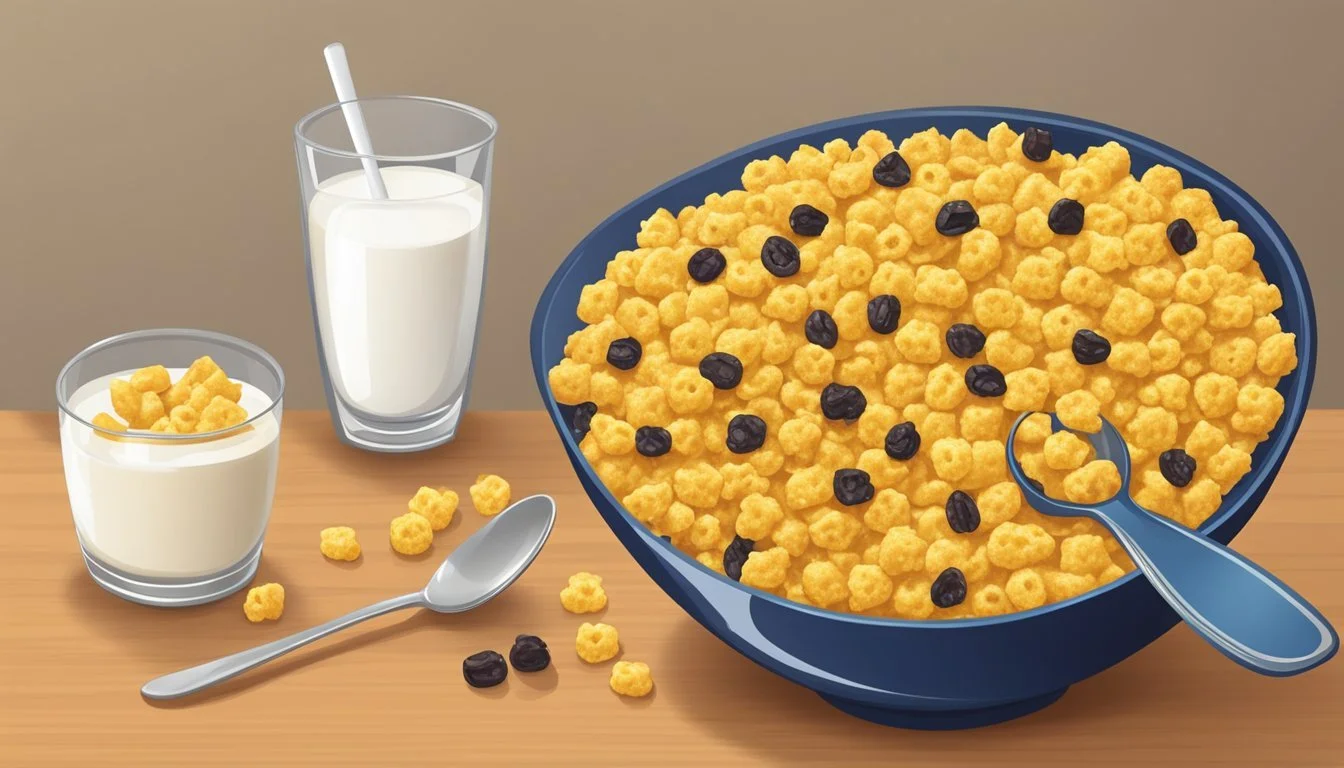Corn Pops vs Post Raisin Bran Cereal
A Nutritional Comparison
This Article is Part of Our Breakfast Cereal Guide with Details on Corn Pops Nutrition and Post Raisin Bran Cereal Nutrition
When it comes to choosing between Corn Pops and Post Raisin Bran, making a healthy breakfast decision can be intriguing. Corn Pops, produced by Kellogg's, is known for its light, crispy texture and sweet taste, while Post Raisin Bran is lauded for its fiber-rich content and hearty feel. Each cereal offers distinct nutritional benefits, making the choice somewhat dependent on individual dietary goals.
For those aiming to increase their protein and fiber intake, Post Raisin Bran stands out as a better option with 3 grams of protein and 6 grams of dietary fiber per serving. Corn Pops, on the other hand, appeal to those who prefer a lower-calorie, lower-sugar choice with only 110 calories and 12 grams of sugar per serving. The nutritional differences can significantly impact your breakfast experience and health outcomes.
By comparing these cereals, this article aims to help readers navigate the cereal aisle with confidence and make informed decisions based on their dietary needs and preferences. The goal is to provide a clear and concise analysis to support healthier eating habits.
Overview of Corn Pops and Post Raisin Bran Cereal
Corn Pops and Post Raisin Bran are two popular breakfast cereals with distinctive features. Corn Pops, made by Kellogg's, is known for its sweet, crunchy corn puffs. Post Raisin Bran, produced by Post, combines whole wheat flakes with raisins, offering a different textural experience.
Manufacturer
Corn Pops: Kellogg's
Post Raisin Bran: Post
Serving Size and Weight
Corn Pops: 1 cup (1.0 oz)
Post Raisin Bran: 0.67 cup (1.33 oz)
Nutritional Information (per serving)
Nutrient Corn Pops Post Raisin Bran Calories 110 120 Protein (grams) 1 3 Fat (grams) 0 1 Sodium (mg) 90 200
Key Vitamins and Minerals
Corn Pops contains more of the B vitamins, including B1, B2, B3, B6, and B12.
Post Raisin Bran is richer in iron, selenium, copper, phosphorus, and magnesium; with 116% more daily iron requirement coverage than Corn Pops.
Textural and Flavor Profile
Corn Pops: Sweet, crunchy, and light.
Post Raisin Bran: Chewy raisins mixed with crunchy wheat flakes.
Health Considerations
Corn Pops: Suitable for those looking for a low-fat, vitamin-rich cereal.
Post Raisin Bran: A better choice for those needing higher iron and mineral intake, though higher in sodium.
Both cereals cater to different nutritional needs and preferences, offering variety to breakfast choices.
Nutritional Profiles
Comparing the nutritional profiles of Corn Pops and Post Raisin Bran reveals notable differences in their macronutrient content, vitamins, and specific ingredients.
Macronutrients and Calories
Corn Pops has 110 calories per serving, with a serving size of 1 cup (28 grams). It contains 1 gram of protein, 0 grams of fat, and 26 grams of carbohydrates. This includes 0 grams of dietary fiber and 12 grams of sugar.
Post Raisin Bran has 120 calories per serving, with a serving size of 0.67 cups (40 grams). It offers 3 grams of protein, 1 gram of fat, and 28 grams of carbohydrates. Additionally, it includes 5 grams of dietary fiber and 17 grams of sugar.
Nutritional Content Comparison:
Nutrient Corn Pops (1 cup) Post Raisin Bran (0.67 cups) Calories 110 120 Protein (g) 1 3 Fat (g) 0 1 Carbohydrates (g) 26 28 Dietary Fiber (g) 0 5 Sugar (g) 12 17
Vitamins and Minerals Content
Corn Pops have minimal vitamins and minerals. Each serving provides a small percentage of daily iron and calcium requirements. However, it lacks significant amounts of other essential vitamins and minerals.
Post Raisin Bran offers a richer profile of vitamins and minerals. Each serving boosts daily intake of iron, calcium, and zinc. It also contains B vitamins such as vitamin B1, B2, B3, B6, and B12, along with vitamin C and magnesium.
Vitamins and Minerals Comparison:
Vitamin/Mineral Corn Pops Post Raisin Bran Iron (%) ~2 20 Calcium (%) ~0 10 Zinc (%) ~0 8 B Vitamins Minimal Significant (B1, B2, B3, B6, B12) Vitamin C (%) ~0 4 Magnesium (%) ~0 6
Specific Ingredients Comparison
Corn Pops primarily uses cornmeal, sugar, and molasses. It features no whole grains and limited fiber, targeting taste more than nutrition.
Post Raisin Bran includes whole grain wheat, bran flakes, and raisins. The presence of whole grains and bran flakes enhances its fiber content significantly. The addition of raisins increases its sugar content but also provides natural sugars and some nutrients.
Ingredients Highlight:
Corn Pops: Cornmeal, sugar, molasses, no whole grains
Post Raisin Bran: Whole grain wheat, bran flakes, raisins, high fiber content
This detailed comparative analysis underscores the stark differences in the nutritional makeup of Corn Pops and Post Raisin Bran. Each offers distinct benefits and drawbacks based on one's dietary needs and health goals.
Health Considerations
When comparing Corn Pops and Post Raisin Bran, it's essential to assess their dietary impact and understand the potential health benefits and risks associated with each cereal.
Dietary Impact
Corn Pops has 110 calories per serving with 1 gram of protein and 0 grams of fat. This cereal contains 90 milligrams of sodium and no dietary fiber.
Post Raisin Bran provides 120 calories per serving with 3 grams of protein and 1 gram of fat. It contains 200 milligrams of sodium and 6 grams of dietary fiber.
Corn Pops is relatively low in protein and fiber, which are crucial for maintaining a healthy digestive system and muscle growth. The higher sodium content in Post Raisin Bran could be a concern for those monitoring their sodium intake. However, it compensates with higher fiber content, contributing to heart health and blood sugar regulation.
Potential Health Benefits and Risks
Post Raisin Bran offers a significant amount of dietary fiber, which can help reduce the risk of heart disease and type 2 diabetes. Its higher protein content is also beneficial for muscle maintenance. However, the increased sodium levels require careful intake, especially for individuals with hypertension.
Corn Pops, with lower sodium and no fat, is favorable for those seeking a low-sodium diet. However, the lack of fiber and minimal protein content may not be suitable for those requiring a more nutrient-dense breakfast option. The absence of adequate macronutrients in Corn Pops means it could lead to quicker spikes in blood sugar, potentially affecting overall glycemic control.
By evaluating these health considerations, consumers can make informed decisions based on their specific dietary needs and health goals.
Taste and Texture Experience
When comparing Corn Pops and Post Raisin Bran, the taste and texture play significant roles.
Corn Pops offer a light and airy texture. The cereal is sweet and has a distinct corn flavor. Each puff delivers a crisp bite that retains its texture even when soaked in milk.
Post Raisin Bran provides a different experience. The flakes are substantial and crunchy, providing a robust texture. Mixed with plump, sugar-coated raisins, the cereal offers a blend of savory and sweet flavors.
Aspect Corn Pops Post Raisin Bran Texture Light, airy, crisp Sturdy flakes, crunchy Flavor Sweet, corn-flavored Savory with sweet raisins Soaked in Milk Retains crispness Stays crunchy Raisins Not applicable Plump, sugar-coated
Sugars also contribute to the taste profile. Corn Pops have a sugary coating, enhancing their sweetness. Post Raisin Bran, with its sugar-coated raisins, strikes a balance with the less sweet flakes.
Other attributes to note include the varying levels of sweetness and how they interact with milk. Corn Pops' sweetness permeates the milk, making it sugary. Post Raisin Bran's raisins infuse the milk with a mild sweetness, while the flakes maintain their hearty crunch.
In summary, each cereal brings a unique taste and texture experience to the breakfast table, appealing to different preferences.
Consumer Information
This section provides detailed information about Corn Pops and Post Raisin Bran to help you make an informed choice. We'll cover manufacturing and brand details, packaging and serving sizes, and value comparisons.
Manufacturing and Brand Details
Corn Pops is manufactured by Kellogg's, a well-known name in the cereal industry. Post, another major player, produces Raisin Bran. Both companies have long histories of producing popular breakfast cereals.
Kellogg's Corn Pops are recognized for their sweet, corn-based taste. Post Raisin Bran combines wheat and bran flakes with raisins for a fiber-rich option. The choice between these cereals often hinges on consumer preference for either a sweet or more nutritious option.
Packaging and Serving Sizes
Kellogg's Corn Pops are generally available in various package sizes, suitable for different consumer needs. One common serving size is 1 cup, weighing approximately 1 ounce. Consumers typically find this information conveniently displayed on the packaging.
Post Raisin Bran usually comes in multiple packaging options as well, with a standard serving size of 0.67 cups, weighing about 1.33 ounces. These details are important for those tracking their dietary intake.
Cereal Serving Size Weight per Serving Calories Corn Pops 1.0 cup 1.0 ounce 110 Post Raisin Bran 0.67 cup 1.33 ounces 120
Price Comparison and Value
When comparing prices, it's essential to consider the value provided by each cereal. Corn Pops tend to be more affordable, catering to those looking for a budget-friendly option. Post Raisin Bran might be priced slightly higher due to its higher nutritional benefits.
While both cereals offer good value, Corn Pops focus on a lower cost, whereas Post Raisin Bran justifies its price with additional nutrients like fiber and protein. Checking for sales or discounts might also influence your decision based on current market prices.
Market Comparison
Corn Pops and Post Raisin Bran cater to different aspects of the cereal market. Corn Pops targets a classic, nostalgic feel, while Post Raisin Bran emphasizes a healthier, fiber-rich option.
Comparative Alternatives Within the Category
When looking at alternatives, other cereals like Cheerios and Wheaties offer low sugar and high fiber, competing with Post Raisin Bran.
Cheerios, made from whole grain oats, are a staple in low-sugar cereals. Similarly, Wheaties, composed of whole grain wheat, provide a high-fiber alternative. Kellogg's Special K, noted for its lower calorie content, also fits within this health-conscious segment.
In contrast, those who enjoy Corn Pops might also gravitate towards more nostalgic or sweeter options. Cereals like Fruity Pebbles and Honey Bunches of Oats with Almonds provide sweet flavors. These cereals, while different in nutrient profiles, attract similar consumer preferences.
Positioning in the Healthy Cereal Niche
In the healthy cereal niche, Post Raisin Bran stands out with its high fiber and protein content. It contains 3 grams of protein and a significant amount of dietary fiber per serving. This makes it a favorite among those looking for nutritious breakfast options.
Kellogg's Corn Pops, with a lighter nutrient profile, cater less to the health-focused consumer. With 110 calories and minimal fat and protein per serving, it is positioned more as an enjoyable, occasional cereal.
Other contenders in the healthy segment include General Mills Total, which offers a comprehensive vitamin and mineral profile. Meanwhile, Special K and Cracklin' Oat Bran provide balanced options with added nutritional benefits.
Raisins in Post Raisin Bran add natural sweetness, positioning it as a tasty yet healthful cereal. Corn Pops, focusing on flavor and nostalgia, do not aim to compete directly in this health-conscious category.
More on Corn Pops
More on Post Raisin Bran Cereal
Cinnamon Toast Crunch vs Post Raisin Bran Cereal: Which is better?
French Toast Crunch vs Post Raisin Bran Cereal: Which is better?
Honey Nut Cheerios vs Post Raisin Bran Cereal: Which is better?
Kellogg's Apple Jacks vs Post Raisin Bran Cereal: Which is better?
Kellogg's Froot Loops vs Post Raisin Bran Cereal: Which is better?
Post GrapevsNut Flakes vs Post Raisin Bran Cereal: Which is better?



